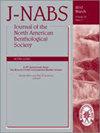Associations between small dams and mollusk assemblages in Alabama streams
引用次数: 41
Abstract
Abstract Small dams are ubiquitous yet poorly understood features in many streams. Dam removal is being used increasingly in stream restoration projects as a means to enhance habitat connectivity and ecosystem function. However, habitat- and assemblage-level effects of small dams on stream mollusk assemblages are poorly documented. We examined associations between stream physicochemical habitat variables and mollusk assemblages at 22 small (<10 m) dams in 3rd–5th order Alabama streams. We sampled 66 reaches (3 reaches/dam) associated with intact, breached, and relict small dams. For each dam, we designated 3 study reaches: 1) immediately downstream from the dam, 2) 500 to 5000 m downstream, and 3) 500 to 5000 m upstream from the impounded or formerly impounded zone. We used principal components analysis (PCA) to examine variation in physical-habitat conditions across all sites. Four principal components accounted for ∼72% of the variation in physical-habitat conditions across sites. One PC score (PC1, corresponding to increased substrate size) was negatively associated with several mollusk metrics including total mussel abundance, taxon richness, catch-per-unit-effort (CPUE), and density. We observed few significant differences between simple habitat variables at sites up- and downstream of dams. However, streams with intact dams had significantly higher mussel catch rates (CPUE) and taxon richness than did streams with breached or relict dams. We used forward-stepwise multiple regression to model the effects of habitat variables (as standardized PC scores) on mollusk assemblage metrics. PCs representing substrate composition were the strongest predictors of total mussel abundance and richness. Abundance of other mollusks including deposit-feeding snails, the exotic bivalve Corbicula fluminea, and fingernail clams was correlated with PC scores describing variability in substrate organic matter composition or stream gradient. We think these data indicate that some intact dams enhance mollusk habitat in downstream reaches. Streams with intact dams appear to be more geomorphically stable than streams with breached or relict dams and conditions in the mill reach may reflect preconstruction stream conditions. Breached dams warrant higher prioritization for removal than intact structures because habitat degradation may persist for decades and impede re-establishment of native mollusk populations.阿拉巴马州溪流中小水坝与软体动物群的关系
摘要在许多河流中,小水坝无处不在,但人们对其知之甚少。作为加强栖息地连通性和生态系统功能的一种手段,拆除大坝越来越多地用于河流恢复项目。然而,关于小水坝对河流软体动物群落的生境和群落水平影响的文献很少。我们研究了阿拉巴马州3 - 5级河流中22个小水坝(<10 m)的河流物理化学栖息地变量与软体动物组合之间的关系。我们对66条河段(3条河段/坝)进行了采样,这些河段与完整的、破裂的和废弃的小水坝有关。对于每个大坝,我们指定了3个研究范围:1)大坝下游,2)下游500至5000米,3)从蓄水区或以前蓄水区上游500至5000米。我们使用主成分分析(PCA)来检查所有站点的物理栖息地条件的变化。四个主要成分占整个站点物理栖息地条件变化的72%。一个PC评分(PC1,对应于底物大小的增加)与几个软体动物指标呈负相关,包括贻贝总丰度、分类丰富度、单位努力渔获量(CPUE)和密度。我们观察到大坝上游和下游地点的简单生境变量之间没有显著差异。然而,有完整水坝的河流的贻贝捕获率(CPUE)和分类群丰富度明显高于有破坏或废弃水坝的河流。我们使用前向逐步多元回归来模拟栖息地变量(如标准化PC分数)对软体动物组合指标的影响。代表底物组成的pc是贻贝总丰度和丰富度的最强预测因子。其他软体动物的丰度,包括以沉积物为食的蜗牛、外来的双壳类河蚌和指甲蛤,与描述基质有机质组成或溪流梯度变化的PC分数相关。我们认为这些数据表明,一些完整的水坝改善了下游的软体动物栖息地。有完整水坝的河流似乎比有破损或废弃水坝的河流更稳定,磨坊河段的条件可能反映了施工前的河流条件。由于栖息地退化可能会持续数十年,并阻碍本土软体动物种群的重建,因此破坏的水坝比完整的结构更值得优先清除。
本文章由计算机程序翻译,如有差异,请以英文原文为准。
求助全文
约1分钟内获得全文
求助全文

 求助内容:
求助内容: 应助结果提醒方式:
应助结果提醒方式:


